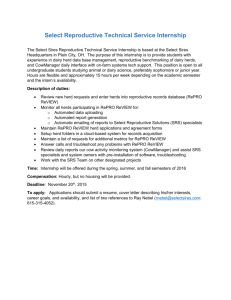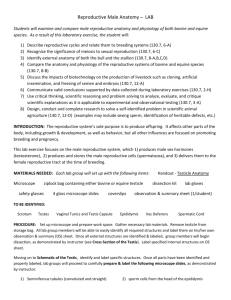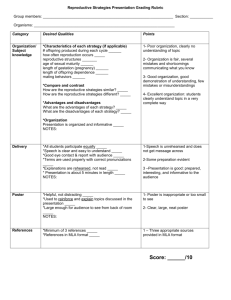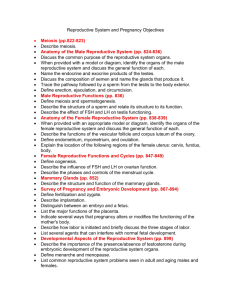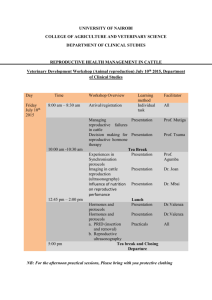Male Reproductive Anatomy
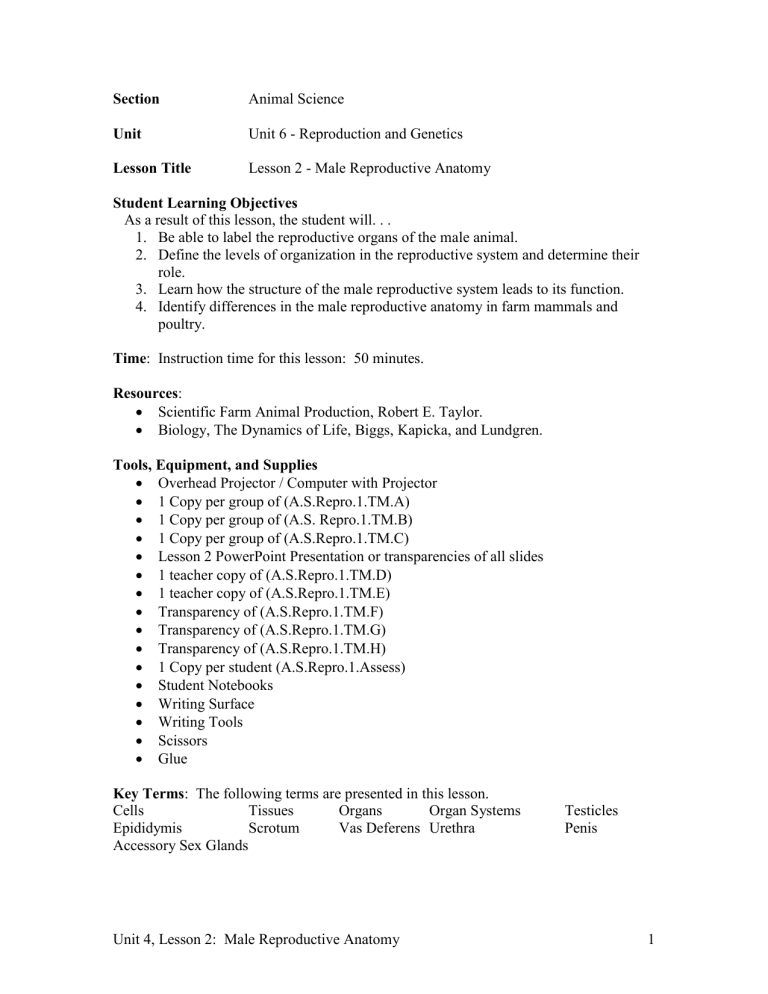
Section
Unit
Animal Science
Unit 6 - Reproduction and Genetics
Lesson Title Lesson 2 - Male Reproductive Anatomy
Student Learning Objectives
As a result of this lesson, the student will. . .
1.
Be able to label the reproductive organs of the male animal.
2.
Define the levels of organization in the reproductive system and determine their role.
3.
Learn how the structure of the male reproductive system leads to its function.
4.
Identify differences in the male reproductive anatomy in farm mammals and poultry.
Time : Instruction time for this lesson: 50 minutes.
Resources :
Scientific Farm Animal Production, Robert E. Taylor.
Biology, The Dynamics of Life, Biggs, Kapicka, and Lundgren.
Tools, Equipment, and Supplies
Overhead Projector / Computer with Projector
1 Copy per group of (A.S.Repro.1.TM.A)
1 Copy per group of (A.S. Repro.1.TM.B)
1 Copy per group of (A.S.Repro.1.TM.C)
Lesson 2 PowerPoint Presentation or transparencies of all slides
1 teacher copy of (A.S.Repro.1.TM.D)
1 teacher copy of (A.S.Repro.1.TM.E)
Transparency of (A.S.Repro.1.TM.F)
Transparency of (A.S.Repro.1.TM.G)
Transparency of (A.S.Repro.1.TM.H)
1 Copy per student (A.S.Repro.1.Assess)
Student Notebooks
Writing Surface
Writing Tools
Scissors
Glue
Key Terms : The following terms are presented in this lesson.
Cells Tissues Organs Organ Systems
Epididymis Scrotum Vas Deferens Urethra
Accessory Sex Glands
Testicles
Penis
Unit 4, Lesson 2: Male Reproductive Anatomy 1
Interest Approach
Divide class into small groups of two or three. Give each group the unlabeled diagram of the male reproductive system of a boar (A.S.Repro.1.TM.A) and a rooster
(A.S.Repro.1.TM.B). Upon giving each group the diagrams you will ask if they know what you have just given them. When you get the correct answer you will give each group copy of the terms (A.S.Repro.1.TM.C) to label the diagrams with a pair of scissors for them to cut out the terms and paste them. Before letting them start, tell them they can use any reference in the classroom to label the diagrams.
I have handed out to each group copies of two diagrams. Can anyone tell me what they are?
You will probably get the answer of boar, but you may have to give several hints before the class gives the answer of rooster.
Excellent, as you all have told me the diagrams are of the reproductive organs of a boar and a rooster. As you may expect there are some differences between the two in structure and function. To learn these differences you are going to work in your groups to label the male reproductive parts of the male boar and rooster on each respective diagram. I will give each of you a paper with all the correct terms. You will need to cut out the terms and glue them to the diagram in the correct place in order to label the reproductive parts.
How are you going to do this, you ask? You and your team members can use any resource on the bookshelf to aid you in this process. Once I have handed out the term page and say, “Go,” you will have five minutes to finish both diagrams. “Go!”
As the class is working walk around the room and aid those groups having trouble.
Your five minutes is up. As you return to your table with your group, be thinking about why it is important to be able to identify the reproductive parts of a farm animal.
(After they are seated, ask the question.) You will end up with a variety of answers.
Among them should be to prepare you for a career involving animals, to identify reproductive diseases, to understand the process of breeding, to understand pregnancy, to understand fertilization, and much more.
Unit 4, Lesson 2: Male Reproductive Anatomy 2
Summary of Content and Teaching Strategies
Objective 1. Be able to label the reproductive organs of the male animal
Now that we know why being able to identify the reproductive structure is important, I need one person to volunteer to share their answers of the boar diagram your group filled out in the activity on the overhead (A.S.Repro.1.TM.A). Please label the diagram with the pen provided. As our volunteer labels the parts, be sure to capture them in your notes.
Give them 30 seconds to complete the diagram. Be careful to watch that the answers are right using the diagram (A.S.Repro.1.TM.D)
Great job! Did everyone else get the same answers? (Give the student a high five.) Now
I need someone to volunteer to label the rooster reproductive diagram.
(A.S.Repro.1.TM.B)
Give them 30 seconds to complete the diagram. Be careful to watch that the answers are right using the diagram (A.S.Repro.1.TM.E)
Wonderful! Did everyone else get identical looking answers? Great! Now that we can identify the parts, it is important for us to know what each part does. To do this, we must consider each part’s level of organization.
Objective 2. Define the levels of organization in the reproductive system and determine their role.
In your science classes you have learned the levels of organization and their roles within organisms. What are the levels of organization within organisms?
Have students call out answers and show (A.S.Repro.1.TM.F) or write the following on a writing surface. Discuss and explain. If the students have little or no knowledge of these concepts, write the four levels on the board in random order and ask the students to write them in order from smallest to largest somewhere in their notes. Then, discuss and explain.
I. What are the levels of organization?
1.
Cells Building block of both unicellular and multicellular organisms; all living things are made of cells
2.
Tissues A group of cells functioning together to perform an activity.
3.
Organs Groups of two or more tissues that function together.
4.
Organ Systems - Cooperation among organs makes life function within an organism efficient.
What are the organs of a male reproductive system collectively called?
Unit 4, Lesson 2: Male Reproductive Anatomy 3
Wait for the response of a reproductive organs organized into an organ system for the purpose of reproduction.
Great! That’s correct the male reproductive system is organs organized into an organ system for the purpose of reproduction.
Objective 3. Learn how the structure of the male reproductive system leads to its function.
Let’s take a closer look at this organ system. Now I want you to think back to the boar diagram you and your group made during the first activity. We are going to go over the major organs of the reproductive system. Show (A.S.Repro.1.TM.G).
II.
Male Organs of Reproduction and Their Functions
1.
The testicles – The testicles produce the sperm cells that fertilize the female’s egg. The sperm are produced in the seminiferous tubules within the testicles. Testosterone is produced here. Testosterone is the hormone that makes the appearance and behavior of a male masculine.
2.
The epididymis
– This is where the sperm are stored from the testicle to mature.
3.
The scrotum – The scrotum is a sac that contains and protects the testicles. It regulates the temperature to be a few degrees lower than body temperature since sperm like this lower temperature.
4.
The vas deferens – The vas deferens transports the sperm from the epididymis to the urethra.
5.
The urethra – A large muscular canal extending from the urinary bladder. This is the pathway through with urine and semen are excreted.
6.
Accessory sex glands – The seminal vesicles, prostate, and bulbourethral glands are a part of this category. They primarily add to the semen fluid to provide health and nutrition to the sperm.
7.
The penis – The organ of copulation. It is characterized by its spongy, erectile tissue. It provides the passage way for urine and semen.
Draw 7 boxes on the board and label them $100 - $700.00. These will be the visual part of your Jeopardy game.
Now that we have seen this information we are going to play a little Jeopardy.
Have the youngest student in the class go first and pick a box. They are all in the same category so all they get to pick is the dollar amount. As they pick boxes read the definitions of the male reproductive parts above at random. Have students answer the question, “What is . . .” Keep score so you can congratulate the winner.
Congratulations,____________ is our winner and reproductive specialist for the day.
Everyone give______________ a round of applause.
Unit 4, Lesson 2: Male Reproductive Anatomy 4
Objective 4. Identify differences in the male reproductive anatomy in farm mammals and poultry.
Now think about the activity we did at the beginning. Was there any difference in the male anatomy of a rooster and a boar? You will get responses like: They included kidneys, Ureters, and Cloaca.
Spectacular, now we are going to take a closer look at some significant differences between the two species.
Show (A.S.Repro.1.TM.E) or copy onto a writing surface the following:
III.
Differences in the poultry male reproductive organs
1.
The testes are contained in the body cavity.
2.
Each vas deferens opens into small papillae, which are located in the cloacal wall.
3.
Male fowl have no penis but have a copulatory organ.
Review/Summary
Have students do a Bob the Weather Guy Moment. Have students summarize the day’s lesson as if it were a weather report. Challenge them to forecast what will happen in the lessons to follow. Have them highlight the highs and frontal systems in the lesson.
Unit 4, Lesson 2: Male Reproductive Anatomy 5
Application
Extended Classroom Activity:
Have students’ research career opportunities in agriculture that utilize reproductive technology. Some examples include veterinarian, artificial insemination technician, embryologist, beef producer, etc. Have them find 5 careers and define each. Have them bring their findings to class the next day to share with everyone.
FFA Activity
Have students compete in the local speaking contest and utilize the topic reproductive technology. Have them highlight how reproductive technology can help any producer no matter the size of the operation.
SAE Activity
Have students share stories about their SAE with the rest of the class about some reproductive problems they may have had in their project. This will show how relevant this material and the material to come are to the production aspect of agriculture.
Evaluation
(A.S.Repro.1.Assess)
Answers to Assessment:
1.
E
2.
B
3.
A
4.
C
5.
G
6.
F
7.
D
8.
Cells Building block of both unicellular and multicellular organisms; all living things are made of cells
Tissues A group of cells functioning together to perform an activity.
Organs Groups of two or more tissues that function together.
Organ Systems - Cooperation among organs makes life function within an organism efficient.
Unit 4, Lesson 2: Male Reproductive Anatomy 6
(A.S.Repro.1.Assess)
Male Anatomy
Matching: Please put the letter of the vocabulary word in column B in the blank corresponding to the definition in column A.
Column A
1.______ This is where the sperm are stored from the testicles to mature.
2.______ The organ of copulation.
3.______ The seminal vesicles, prostate, and bulbourethral glands are a part of this category.
4.______ These produce the sperm cells that fertilize the female’s egg.
5.______ This is a sack that contains and protects the testicles.
6.______ This transports the sperm from the epididymis to the urethra.
7______ A large muscular canal extending from the urinary bladder.
Short Answer:
8. Describe the four levels of organization.
Column B
A. Accessory Sex Glands
B. Penis
C. Testicles
D. Urethra
E. Epididymis
F. Vas Deferens
G. Scrotum
Unit 4, Lesson 2: Male Reproductive Anatomy 7
Unit 4, Lesson 2: Male Reproductive Anatomy 8
Unit 4, Lesson 2: Male Reproductive Anatomy 9
Unit 4, Lesson 2: Male Reproductive Anatomy 10
Unit 4, Lesson 2: Male Reproductive Anatomy 11

